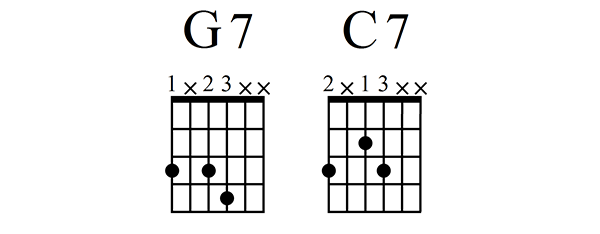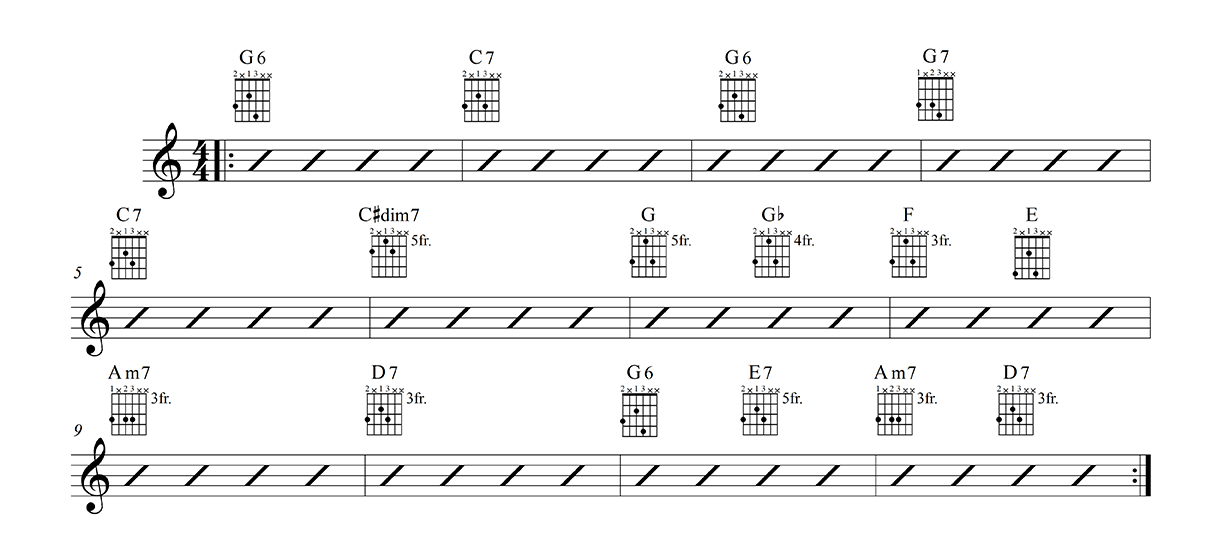
Here’s the scenario; the middle school jazz band needs a guitarist. The best applicant is a rocker, who has some facility, can play in time, and is interested.
The first tune is a Basie-style swing tune. The chart says Ab7. The guitarist can produce a six string barre chord of the same name, but what’s next?
What’s next is uncomfortable for everyone in the room. I know because I was that guitarist.
Freddie Green Can Help
In time I was fortunate to befriend more experienced musicians with whom the name Freddie Green often came up. Green was the rhythm guitar legend of the Count Basie band. At first I didn’t fully understand his greatness; I often found it hard even to hear him in the classic recordings. Can you always hear your heartbeat (even in a noisy room)? Nope. Does that make its rhythm any less crucial? I don’t think so. Check out the chugging sound in this clip.
What do I wish I had known before that first rehearsal? Well, lots of things. But let’s start with some appropriate voicings that you can share with your students.
Three Note Rhythm Chords
Chord voicings are integral to the Green style, specifically voicings that only use a few strings. In addition to being easy to grab (and lending themselves to motion) their sparse nature also leaves more sonic space for other instruments. This space, combined with Green’s complete lack of grandstanding volume, may offer a life lesson. Maybe it’s more about making the whole band sound good than it’s about proving the guitar player is awesome.
Sermon aside, the good news for young guitarists is that these voicings are not hard to play. Let’s start with these two:
 NOTE: Numbers represent finger (pointer is #1) and the x means these strings are muted.
NOTE: Numbers represent finger (pointer is #1) and the x means these strings are muted.
Check this out: the C7 chord doesn’t even have the root (a C) in it. That took me a bit of time to get used to. This fact that the root is optional is a valuable lesson, although guitarists may visualize the root (in this case 3rd fret, 5th string) when playing it. With just these two voicings your student could play an entire simple blues (sliding C7 up two frets to play D7).
G7 |C7 |G7 |G7
C7 |C7 |G7 |G7
D7 |C7 |G7 |D7
The trick here is to mute the other three strings so all strings can be strummed while only sounding three notes. In the G7 chord, the side of the first finger just touches both the 5th string, and the 1st and second strings, preventing them from vibrating. Getting this to happen takes a little trial and error, but’s it’s not physically tough like barre chords can be.
The Right Hand
To start, students should play these voicings with quarter note down-strokes. Chug, chug, chug, chug. Next, have them add an accent on beats two and four. The simple blues above, played with just these two voicings, can really drive a whole tune in a musical way. It just takes some practice to make it happen.
Learning Harmony
One music theory goal could be to get your guitarist to see every note of these voicings as it relates to the root of the chord. The G7 voicing (low to high) is root, b7, 3rd. The C7 is 5th, 3rd, b7. When they can identify these chord tones to you, and you’ve explained the difference between G7, GMaj7, G, G6, and so on, they can begin to discover their own voicings by understanding how each note relates. Plus this is all made a little more obtainable by the fact there are only three notes: it’s less to juggle in their mind.
Note how this is a very different process than trying to memorize a chord chart; I’m reminded of the Chinese proverb: Give a man a fish and you feed him for a day. Teach a man to fish and you feed him for a lifetime.
Take Things Further
Got a student who’s already mastered the simple blues above? Here’s something that’s a little more fun:

Here are a few things to observe:
- If a chord chart says G7, could one substitute G or G6 or Gmaj7? This is a type of conversation you might have with your students. G7 and Gmaj7 look very similar, but work very differently; G or G6 could work,
- Check out the C#dim7: this is just the C7 voicing slid up a minor third (creating bb7, b5, 1).
- At the top of bar 7, I threw in a G triad, which is a subset of G7. The third is in the bass: again, you don’t need the root, and it doesn’t HAVE to be in the bass!
Additional Ingredients
Of course, additional ingredients include listening to music – including classic recordings – and playing, both with a metronome and with others. But you knew that.
If you have a rock guitarist in your jazz band, I hope this is of help to both of you. If so, click on the Like button above or comment on Facebook and Twitter. If we hear from you, we’ll share more on this topic.
 In addition to being MakeMusic’s content manager, Scott Yoho is the leader of the Auto Body Experience, a horn-driven septet that plays his quirky music.
In addition to being MakeMusic’s content manager, Scott Yoho is the leader of the Auto Body Experience, a horn-driven septet that plays his quirky music.
A graduate of the Musicians’ Institute, he earned a B.A. in English from the University of Minnesota. Yoho played guitar with Rock and Roll Hall of Fame member Gene Pitney for ten years, and has performed on stages as diverse as hay wagons, VFW basement floors, and Carnegie Hall.
Scott’s recordings have been featured in music magazines including Guitar Player, Vintage Guitar, and Keyboard, and he was once interviewed by NPR’s Terry Gross on Fresh Air.